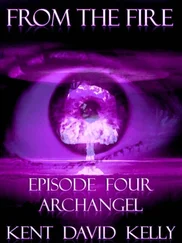So far, so good; she was glad to see the whirling discs again, but then … her hand was writing, words flowing smoothly and rapidly, but her mind had stopped catching hold. Was it that what he was saying didn’t make sense, or that she wasn’t concentrating? Action at a distance cannot take place, with the exception of mental action, or telepathy — she looked down at the paper; had he just said that? — and the actions of gravitation, magnetism, and electric force require some intervening medium. The nature of that medium is mysterious, but it might be thought of as a jelly-like substance filling all space.
“A body cannot act where its influence is not,” her pencil wrote, but her wayward mind pictured a giant jellyfish, pulsing faintly, stretching in all directions. The pictures were always wrong; only the mathematics conveyed the truth. “Another and perhaps a better way of putting it is to say that one body can only act on another through a medium of communication. When a horse pulls a cart, it is connected by traces; when the earth pulls the moon, it is connected by the ether; when a magnet pulls a bit of iron, it is connected by its magnetic field, which is also in the ether.”
Here he reached below the podium, brought up a candy box striped in yellow and green, and set the box on a table beside him. “Would it be magic,” he said, reaching for his cane, “if, by waving this, I caused the box to move?”
Sam was staring raptly at the stage — as indeed was the entire audience. Lodge passed his cane through the air, two feet above the box. The box slid sideways on the table.
“Hey!” Sam said, leaning so far forward that his chin would have brushed the hair of the woman sitting in front of him, had she herself not been leaning over the balcony rail. His own hair was a beautiful color in this light. Lodge raised the cane above his head and the box rose from the table.
After the exclamations from the audience subsided, he smiled modestly and lowered the cane. “When you see action of this kind,” he said — the box settled back down—“always look for the thread.”
What a showman. The thread was invisible at this distance, but he caught it between the cane and the box and suggested, by a tugging gesture, how it was connected.
“Always look for the medium of communication,” he said. “It may be an invisible thread, as in this conjuring trick; it may be the atmosphere, as when you whistle for a dog; or it may be a projectile, as when you shoot an enemy. Or, again, it may be ether ripples, as when you look at a star. You cannot act at a distance without some means of communication; and yet you can certainly act where you are not, as when by a letter or telegram you bring a friend home from the Antipodes. A railway signalman can stop a train or bring about a collision without ever touching a locomotive. A conclave of German politicians could, and did”—his voice rose here, making Phoebe look up from her pad—“operate on innumerable families in England and slaughter their most promising members without the direct action of a finger.”
She felt a small tremor, as if that finger had moved, miles away, through the water in which she floated. “No one wants to be deceived,” he continued. “All are eager for trustworthy information about both the material and the spiritual worlds, which together constitute the universe. The ether of space is the connecting link. In the material world it is the fundamental substantial reality. In the spiritual world the realities of existence are other and far higher — but still the ether is made use of, in ways which at present we can only surmise.”
Her pencil stopped, but he did not. She could feel him gathering up his thoughts, preparing for some final argument.
“Last May,” he continued, “when astronomers measured the bending of a ray of light around the sun during an eclipse, they obtained data that when measured made Einstein’s theory of gravitation appear to triumph. But what is the meaning of this triumph? Is it the death knell of the ether?”
Before Phoebe could frame an answer, Lodge surged on. “Must we now think in terms of four or even five dimensions to explain this warp or curvature of space? In my opinion, we ought clearly to discriminate between things themselves and our mode of measuring them. The whole relativity trouble arises from ignoring absolute motion through the ether, rejecting the ether as our standard of reference and replacing it by the observer.”
The whole relativity trouble —that simple phrase made Einstein’s theory seem a piece of trickery as foolish as the thread. Caught in the smooth stream of words, Phoebe could question his logic only when she split her attention in two and set one part struggling against the flow. Yet even as she was giving up — he was now discussing the relationship between matter and the ether — he said something that made her write faster.
“Undoubtedly the ether belongs to the material universe, but it is not ordinary matter. It may be the substance of which matter is composed. If you tie a knot in a bit of string, the knot is composed of string, but the string is not composed of knots. The knot differs in no respect from the rest of the string, except in its tied-up structure; it is of the same density as the rest, and yet it is differentiated from the rest. In order to cease to be a knot, it would have to be untied — a process which as yet we have not learned how to apply to an electron.”
There — that was why she admired him, why she’d come tonight. That was the kind of image she searched for in her own work and found, when she was lucky, with a sense of release that was almost physical. He was not a charlatan; he was a scientist who’d made real discoveries — he, as much as Marconi, had discovered the basic principles of the radio — and he’d drawn many to science through his lectures and his books. He might be old, and distinguished, and British, and a man; capable, as she had not been for years — had she ever really been? — of doing real science: but still they had more in common than just bolting from disagreeable ideas. How strange that what he seemed to care most about now was the possibility of communicating with the dead.

THE LECTURE LIGHTENED something in her, or perhaps it was Sam’s presence beside her; his arm next to hers, his mind engaged, however briefly, with something that absorbed her. The distance between them had grown, she would have said a week earlier, because he’d developed his own interests, which he didn’t talk about much. On the train ride home, though, she considered how little she’d recently shared with him, so busy that she’d lost the habit of explaining her work. But as soon as she’d exposed him to Lodge he responded, which might mean that he’d be interested in the rest of the project; perhaps she could share other sections with him: perhaps the book would be wonderful! With a burst of enthusiasm, she began to draft her chapter on the ether.
First a bit of history: a quick glimpse of Descartes and his whirling vortices, and then the newer conceptions answering the need for a subtle medium, universally diffused, that could propagate the undulations of light and electricity while also transmitting the pull of gravity. Waves in the ocean travel through water; light waves must travel through a similar interstellar ocean, which we can neither see nor feel nor weigh. This is the ether, nowhere apparent but everywhere implied. The ether, which, until quite recently, most scientists had assumed must exist. How then might we conceive of this omnipresent, impalpable, invisible something?
She touched on Maxwell’s ingenious models and the various arrangements by which wheels and rubber bands, gears and pulleys and springs had been set to represent possible mechanisms. Neatly she fit after those pages the sketch she’d made of Lodge’s experiments with the whirling machine. Then on to the more recent and less mechanical conception of the ether as the ground from which both matter and energy arise. From Lodge’s lecture — she pushed aside the tangle of upsetting digressions and disturbing assumptions — she lifted the image of knots on a string, matter as coiled-up ether: matter may be, and likely is, a structure in the ether, but certainly ether is not a structure made of matter.
Читать дальше













